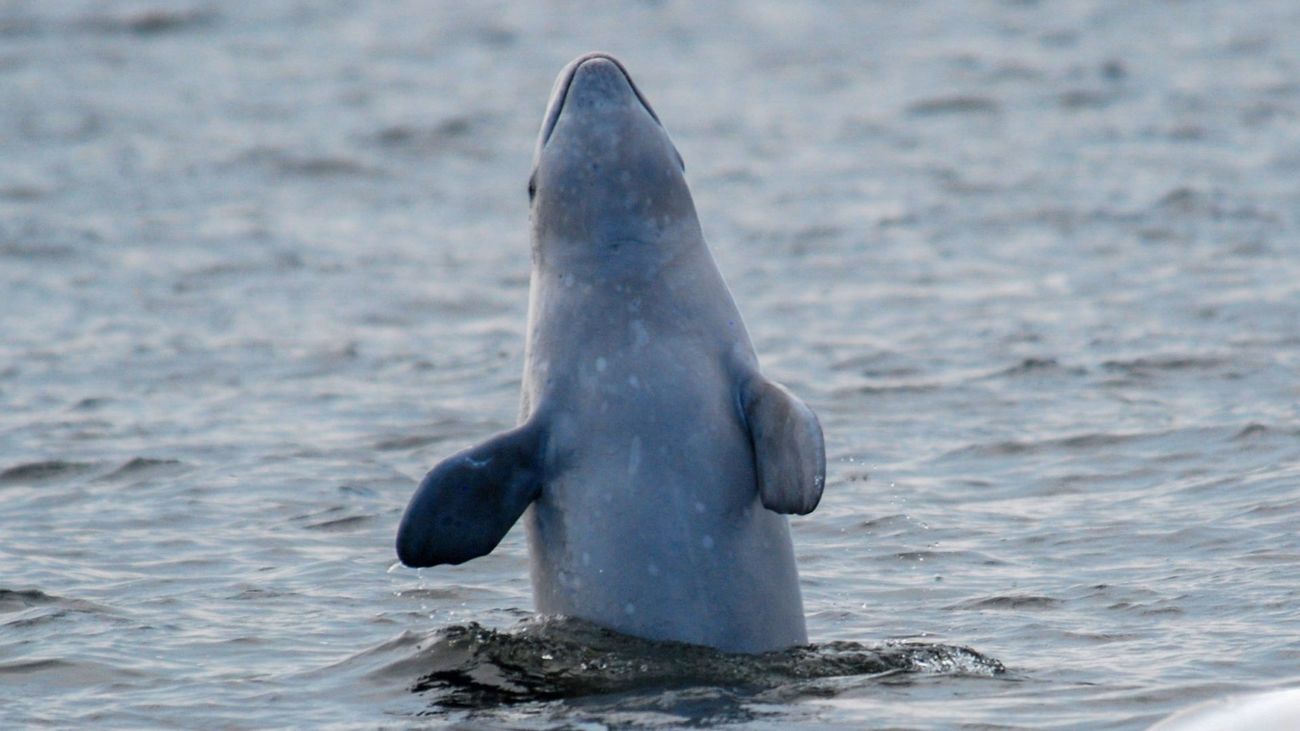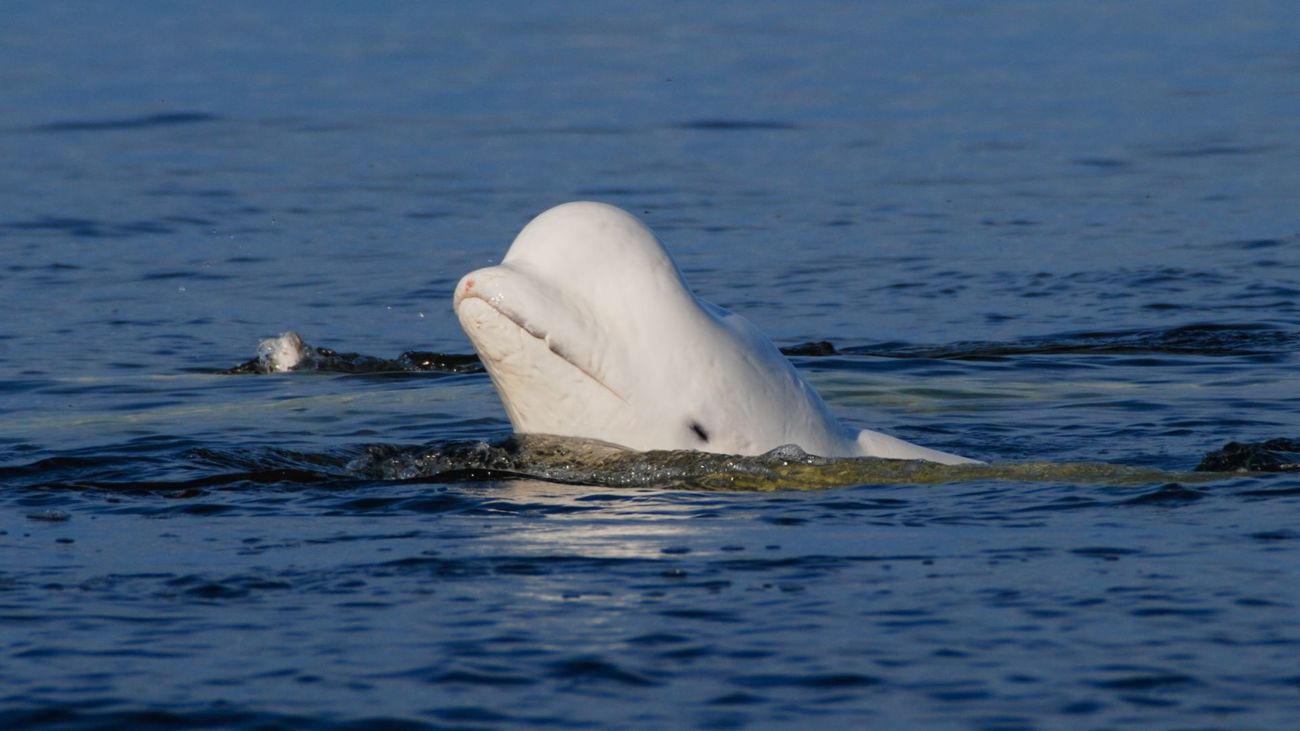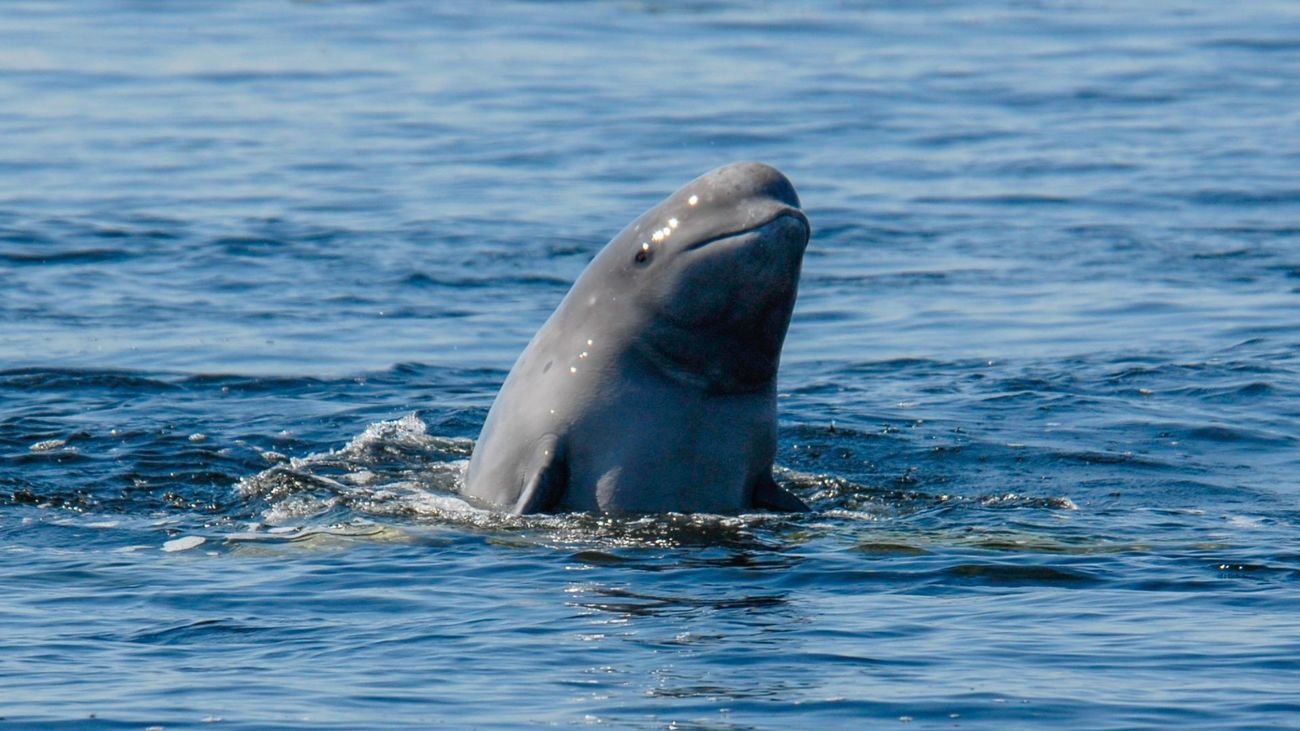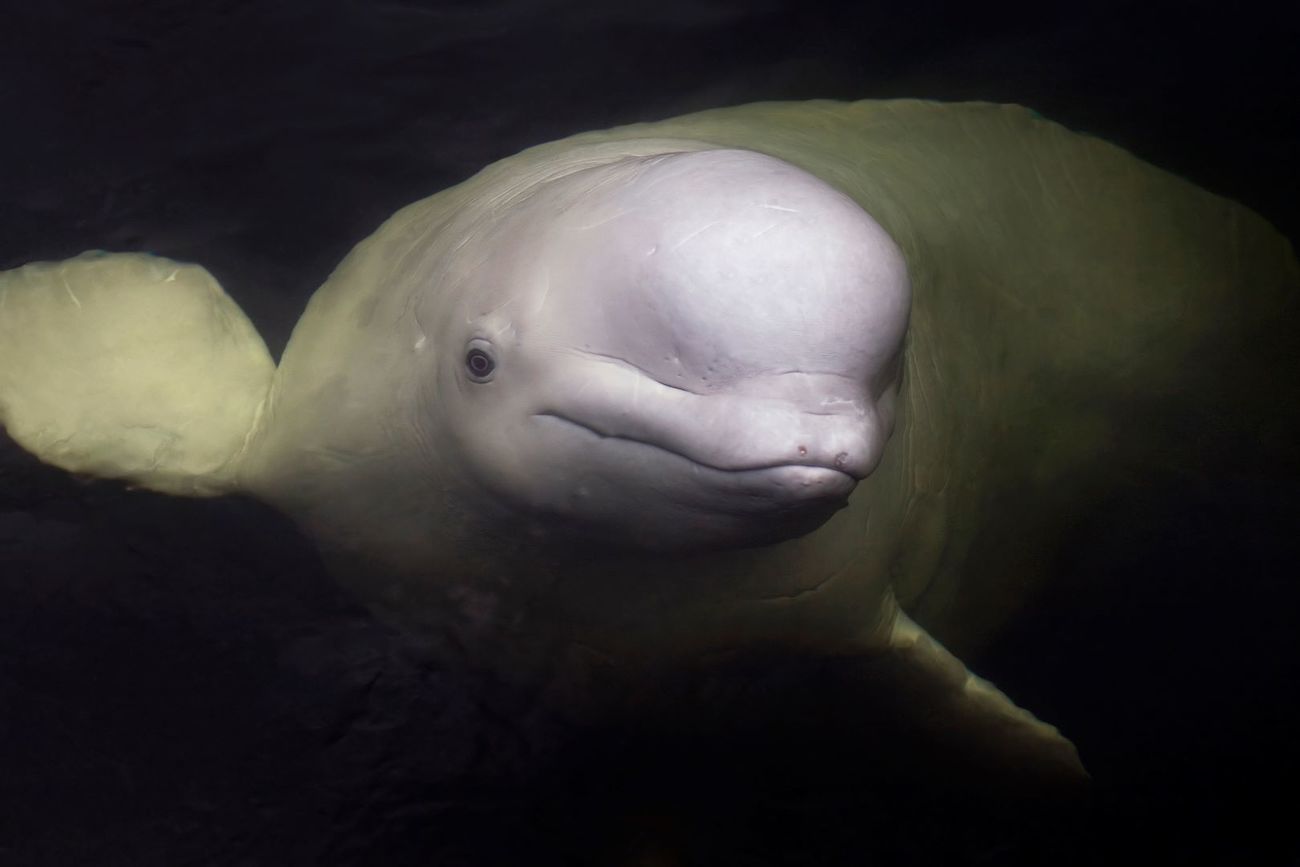Belugas
Also known as the white whale, the pearly colour of the beluga makes it stand out among other whales. When they are born, beluga pups are grey or brown, but as they grow, they slowly fade to a white colour—a process that’s usually complete by the time they turn five years old.
Another striking feature of the beluga is its large round forehead, which is squishy and referred to as a melon. This organ is filled with oil and wax and helps belugas control the frequency of the sound waves they create, improving their echolocation abilities. When they use the melon, it changes shape depending on the sound they’re making. The beluga’s brain is located much further back in its head, separated from the melon by its blowhole and protected by its skull.
Belugas are very social animals and live together in pods or groups made up of family and friends. The average pod size is 10, though they can include as many as 25 individuals. Several pods will travel together sometimes during migration, forming groups of thousands.
As far as researchers can tell, belugas have a complex social structure and varied relationships within these groups. Current observational studies suggest beluga pod members have shown interesting behaviours, including caring for young that aren’t their own and playing with each other.
During winter, when the Arctic Ocean freezes over in many places, many beluga pods will migrate to warmer waters. They can end up around the UK, Nordic countries, the US Pacific Northwest, and Japan. They can also be found at river mouths and sometimes even swim upriver.
During their journey out of the Arctic, sea ice pieces can break apart and crash into each other, creating dangerous situations for belugas. They can drown if they are stuck under ice and can’t find a place to come up for air.
Beluga whales have slow reproductive habits. Female beluga whales give birth to one calf roughly every three years. Breeding takes place in the spring on special breeding grounds that the belugas return to each year. Females reach sexual maturity after 4-10 years, while males take 8-15 years. Pregnant beluga females carry their young for 14 months and nurse them for two years. Parents can end up in the same pod as their children, but they can also move around and separate from each other.
Belugas are considered top predators in the ocean, meaning they play an important role in regulating the population of prey species by picking off ill or injured individuals. They also provide a food source for orca whales and polar bears.
What is a beluga’s scientific name?
The beluga’s scientific name is Delphinapterus leucas, which means ‘dolphin without a fin’ in Latin. Its common name, beluga, was borrowed from the Russian word for white, and other common names include white whale and belukha. Because of the wide range of noise and vocalisations beluga make, they are also sometimes known as the canary of the sea.
Are belugas endangered?
Beluga whales were considered vulnerable by the IUCN in 1996, changed to near threatened in 2008, and changed again to least concern in 2017. However, a specific subpopulation of belugas in Cook Inlet in Alaska has been assessed separately and listed as critically endangered on the Red List. This subpopulation is also considered endangered under the Endangered Species Act in the US.
Where do belugas live?
Beluga whales live in the Arctic Ocean around multiple countries, including Canada, Greenland, Russia, and the US (mainly in Alaska). When they migrate, they pass through the waters of many other countries, including the UK, Denmark, Japan, Norway, Sweden, and the Faroe Islands. While some beluga whales live permanently in one area, many migrate to warmer climates during the winters when the Arctic water freezes.
Threats
Beluga whales, though not classed as endangered, are still a protected species under the Marine Mammal Protection Act and face several threats. These include captivity, hunting and fishing, pollution, and noise pollution—all directly connected to human activity.

Captivity
Belugas have long been a staple in aquariums and other animal parks, but the ethics of this practice are currently in question. While it is no longer permitted to catch wild belugas and display them in captivity, many places still have beluga exhibits and breeding programs.
While the organisations claim the whales thrive in their enclosures and that the research opportunities they provide are invaluable, many wildlife scientists disagree. Mortality rates of breeding programs are high, and the effects of low-sensory environments may harm belugas’ mental health. Some scientists also argue that the research that comes out of aquariums is low-priority compared to studies conducted in the wild.
Hunting and fishing
Hunting and fishing greatly depleted beluga populations in the 19th and 20th centuries when they were hunted for their oil, flesh, and hides. Currently, belugas are only hunted in the Arctic, where some indigenous communities still rely on them for food. This level of hunting is mostly sustainable but is still regulated to ensure the current beluga population can withstand the losses.

Water pollution
Water pollution from agricultural runoff, sewage and chemical spills, and more can be highly toxic to whales and other marine life. In the St. Lawrence River in North America, a combination of commercial hunting and pollution reduced the population of beluga whales in the St. Lawrence Estuary from thousands at the beginning of the 20th century to around 900 today. These belugas struggle because of the pollutants in their environment and food sources, which then accumulate in their organs.
Noise pollution
Noise pollution is especially threatening to marine mammals like beluga whales. Because they use sound to locate food and friends, human-made ocean noise can make echolocation impossible, resulting in lost, hungry whales. If a whale is stuck in a noisy area for too long, it can lead to injury or death.
FAQs
What do beluga whales eat?
Beluga whales eat various sea creatures, including octopuses, squid, shrimp, clams, snails, and sandworms. They also eat many fish, including eulachon, cod, herring, smelt, flatfish, and salmon.
How do beluga whales communicate?
Beluga whales use a variety of sounds to communicate with each other. In a group, they use a range of whistles, squeals, moos, and chirps to talk to each other. It’s believed that they warn each other when a predator is nearby, but studies into the particulars of their communication system are still ongoing. Underwater, beluga whales also use echolocation clicks to spot prey, navigate, and find their friends. When the whales send a click off in a direction, they can hear when the sound waves hit an object and understand where they are.
Are beluga whales friendly?
Beluga whales are very social creatures and are known to, unlike many other whales, interact with others outside their families. They make friends with new whales and form groups with complex structures. This social attitude and their level of intelligence also make them very curious, and it’s not uncommon to see a beluga whale approach humans in boats.
However, humans should refrain from interacting with whales in these situations. This is for the safety of both the people and whales, as both can end up with injuries.

Are beluga whales dolphins?
Although they look similar, belugas are not a type of dolphin. They are, however, part of the same toothed whale group that includes dolphins, narwhals, and sperm whales. There are 77 different species of toothed whales, which—as the name suggests—all have teeth of some kind.
How many beluga whales are left in the world?
Global population estimates range between 150,000 and 200,000 beluga whales, and the IUCN estimates 136,000 mature individuals (not counting young). Whether their numbers are stable, increasing, or decreasing is currently unknown.
How big is a beluga whale?
At birth, beluga whales are around 1.5 metres long and weigh 40-60 kilograms. As they grow, males can reach up to three times this length (4.5 metres), and females can grow to around 3.5 metres. Adult belugas weigh 450-1,500 kilograms.

Can beluga whales see colour?
While belugas have good vision that allows them to focus both underwater and out of the water, they likely don’t see colour. This is because they only have one type of cone cell in their eyes; usually, two or more are needed to distinguish colours.
How long do beluga whales live?
Beluga whales live for around 35-50 years in the wild. This might seem like a long time, but it’s short compared to their close relatives, narwhals, who can live for more than 100 years.
Our work
Through our work to reduce underwater noise pollution and the risk of collisions with ships and other vessels, IFAW is working to safeguard the populations of bowhead whales to ensure their survival.
Sonic Sea, a poignant, 60-minute documentary by Imaginary Forces and the Natural Resources Defense Council (NRDC) in association with IFAW, sheds light on the detrimental consequences of increasing industrial and military ocean noise on marine life, particularly whales. With narration by Rachel McAdams and a feature from Sting, the film not only highlights the challenges but also presents solutions and optimism for a quieter ocean. It underlines that, unlike other pollutants, ocean noise can be swiftly eradicated once its sources are eliminated. Global scientific communities and authorities like NOAA, the EU, and the IMO have been advocating for noise reduction, while industry-specific noise-quieting technologies are emerging. The film calls for political commitment to implement these solutions and urges individuals to learn more about the issue and support efforts to reduce ocean noise pollution across the globe. Sonic Sea received three Emmy Award nominations in 2017.
IFAW’s Blue Speeds campaign similarly promotes action to make our ocean quieter, safer, and healthier for whales, including the bowhead whale. Elevated ship speeds are a major cause of underwater noise pollution in the ocean, which causes stress, disturbance and interferes with critical whale behaviours, as well as the behaviour of other marine life. By slowing ship speeds, we can help to create a safer and quieter home for whales and all marine animals.
How can you help?
IFAW is committed to protecting whales around the world. By signing our petition, you can help us create a safer, quieter ocean for whales.
